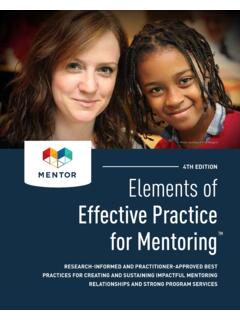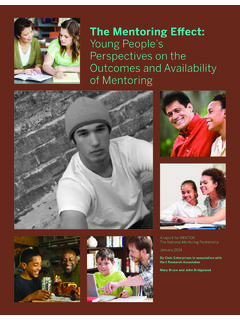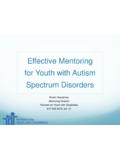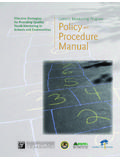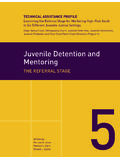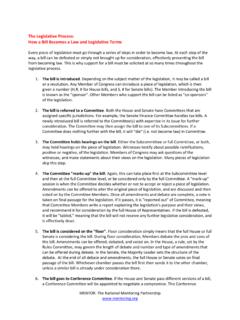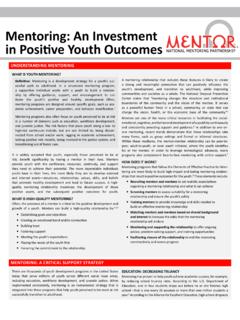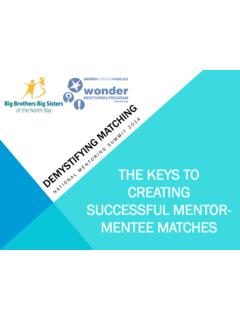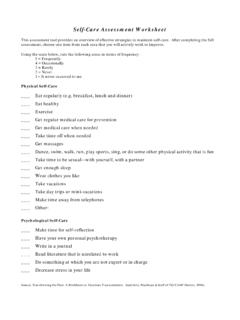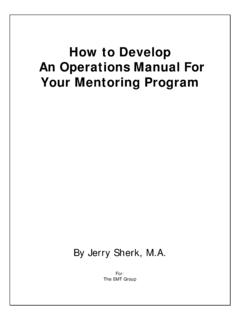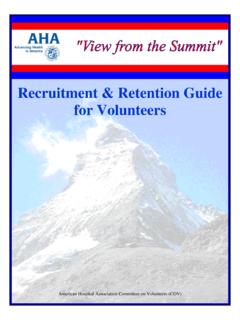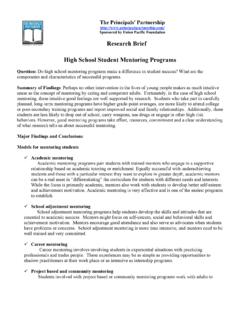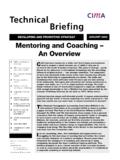Transcription of 4TH EDITION Elements of Effective Practice for Mentoring
1 Photo courtesy of First Niagara 4TH EDITION . Elements of Effective Practice for Mentoring . RESEARCH-INFORMED AND PRACTITIONER-APPROVED best . practices FOR CREATING AND SUSTAINING IMPACTFUL Mentoring . RELATIONSHIPS AND STRONG PROGRAM SERVICES. AUTHORS/STEERING COMMITTEE. Michael Garringer, MENTOR: The National Mentoring Partnership Dr. Janis Kupersmidt, innovation Research & Training D. r. Jean Rhodes, Center for Evidence-Based Mentoring , University of Massachusetts Boston Dr. Rebecca Stelter, innovation Research & Training Tammy Tai, MENTOR: The National Mentoring Partnership ADVISORY COMMITTEE.
2 The Steering Committee would like to thank the members of the Elements of Effective Practice for Mentoring Advisory Committee for their assistance in reviewing and strengthening the Benchmarks and Enhancements throughout this EDITION . This resource would not have been possible without their expertise and support. Heather Clawson Communities in Schools Sue Anne Endelman Mass Mentoring Partnership Janet Heubach Mentoring Works Washington Celeste Janssen Institute for Youth Success Dr. Michael Karcher University of Texas San Antonio Sarah Kremer Independent consultant (formerly of Friends for Youth).
3 Kristin Romens Big Brothers Big Sisters of America Dr. Sarah Schwartz University of Massachusetts Boston Dr. Renee Spencer Boston University COPYRIGHT INFORMATION. 2015 MENTOR: The National Mentoring Partnership 4TH EDITION . Elements of Effective Practice for Mentoring . RESEARCH-INFORMED AND PRACTITIONER-APPROVED best . practices FOR CREATING AND SUSTAINING IMPACTFUL Mentoring . RELATIONSHIPS AND STRONG PROGRAM SERVICES. iv v Elements OF Effective Practice FOR Mentoring . INTRODUCTION 2. ABOUT THE 4TH EDITION 4. STANDARD 1: RECRUITMENT 10.
4 STANDARD 2: SCREENING 24. STANDARD 3: TRAINING 34. STANDARD 4: MATCHING AND INITIATING 54. STANDARD 5: MONITORING AND SUPPORT 60. STANDARD 6: CLOSURE 70. PROGRAM PLANNING AND MANAGEMENT 76. Photo courtesy of Mentoring Works Washington PROGRAM PLANNING AND MANAGEMENT 1. INTRODUCTION. In 2015, MENTOR: The National Mentoring Partnership celebrates 25 years of serving as the unifying champion for the youth Mentoring movement. Over this quarter century, MENTOR has led a series of signature initiatives to continuously improve our nation's ability to meet the Mentoring needs of all young people creation and coordination of National Mentoring Month, an annual campaign endorsed by every President since 2002; successful advocacy for increased public and private investments in the field; and the support and expansion of a national network of affiliate Mentoring Partnerships that provide leadership at the local level.
5 The Elements of Effective Practice for Mentoring is the cornerstone of all of our efforts, developed and disseminated to ensure that as the quantity of Mentoring grows, quality remains front and center. The Elements are widely accepted as the national and global standards for quality youth Mentoring . The very first EDITION of the Elements was created in 1990, when a coalition of youth- serving organizations came together to discuss service-delivery strategies and emerging best practices in the rapidly expanding youth Mentoring arena.
6 These organizations, convened by MENTOR and United Way of America, each approached Mentoring from slightly different perspectives and utilized mentors in a variety of settings and contexts. Yet they had a common and pressing concern: How to ensure that Mentoring programs offered their services in a responsible way, one that met the needs of both youth and volunteers while also ensuring participant safety and positive outcomes for young people and communities. To meet this need, they developed a set of guidelines, or common principles 1 to help guide the development of quality Mentoring programs across the country and support the growing field of Mentoring professionals.
7 This ethos continues in the Elements today the guidelines presented here are intended to be applicable across almost every type of program to help ensure that the youth Mentoring relationships are safe, Effective , and well-managed to produce positive outcomes for the young people involved. The third EDITION of the Elements , released in 2009, further invested in this notion of quality by diving deeply into the existing research on youth Mentoring to find evidence of program practices and relationship strategies that facilitate meaningful Mentoring relationships and positive outcomes for youth and adult participants.
8 This was the first attempt to ensure that the core benchmarks of program quality were grounded in the best research available. 2 Elements OF Effective Practice FOR Mentoring . The fourth EDITION reinforces this application of research our Steering Committee reviewed over 400 peer-reviewed journal articles and research reports, placing particular emphasis on research released since the third EDITION in 2009. And because research and Practice must always be complementary, we also relied on the real-life experience and input of over 200 practitioners and Mentoring organizations.
9 The end result is a document that reflects the best and most up-to-date thinking our field has to offer. It represents 25 years of evolution at MENTOR and in the Mentoring field, and the continuous refinement of practices aimed at ensuring Mentoring relationships deliver on the promise of being a powerfully driver of support and opportunity for young people of all ages. Mentoring continues to grow in diverse directions and is embedded into myriad program contexts and services. The fourth EDITION of the Elements of Effective Practice for Mentoring is intended to give this generation of practitioners a set of programmatic standards that will empower every agency and organization, and raise the bar on what quality Mentoring services look like.
10 We hope this EDITION benefits programs of all sizes and funders from every sector in creating, sustaining, and improving Mentoring relationships because they are critical assets in young people's ability to thrive and strive. David Shapiro President and CEO, MENTOR: The National Mentoring Partnership Mike Garringer Director of Knowledge Management, MENTOR: The National Mentoring Partnership 1 National Mentoring Working Group. (1990). Elements of Effective Practice . Philadelphia, PA: United Way of America. INTRODUCTION 3.
